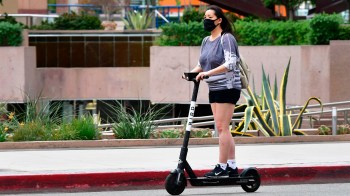Can’t afford gas? Try a ‘commuter bike’
TEXT OF STORY
Kai Ryssdal: There’s some evidence commuting to work by bicycle is on the rise. A survey out from the advocacy group Bikes Belong says sales of what’re called commuter bikes, those are bikes designed for short city trips, [is up]. There’s some good reasons. Maybe it’s a desire to cut down on greenhouse gas emissions. Or maybe it’s gas still at $3.75 a gallon, although you can drop a pretty penny on consumer bikes if you want to. Marketplace’s Sean Cole got to ride one for nuthin’.
Sean Cole: Wow, I am once again in the saddle.
I hadn’t ridden in years. But I had to try one of Mike Flanigan’s bikes. Mike runs a one-man factory in Holliston, Mass., called Alternative Needs Transport, or ANT. Each bike takes him maybe a week to build. His waiting list is a year long.
Cole: My god, I really haven’t ridden in so long this feels really
strange.
Mike Flanigan: Well, they say you can never forget.
I’d actually never heard of a commuter bike. It just means a bike with fenders and a chain guard, upright handle bars, maybe a basket, definitely lights and a bell. [bell rings] In this case a special bell from Japan. You have to be up close to see how well made Mike’s bikes are, and you might never
guess the price. His base model runs $2900.
Flanigan: And actually mine is on the low end of the high end market.
Cole Really?
Flanigan: Oh yeah. People can spend upwards of $10,000 dollars for a bike.
Or as little as $400 to $1,000 for a factory-made commuter bike. But since Mike’s bikes are handmade in America, they’re gonna be pricier. Plus, he fits each one to the customer’s height. He’s been doing this for six years, long before there was so much interest in commuter bikes. He says it used to be that the big manufacturers would only dip their toe into the market now and then.
Flanigan: Like Specialized tried that in the early ’90s, I think it was. They had a bike called the Globe. Very nice bike. Reasonable priced. Completely failed in the market. Gas was still cheap. Bicycles were still toys. It just, the market wasn’t ready for it.
But last fall, he says, at an annual trade show called Interbike, a lot of the big brands were finally hawking bicycles built for commuting.
Richard Fries: It’s not a matter of do they have it in their fleet, you know, it’s sort of where they position it in their booth.
Richard Fries is development director for Bikes Belong, which did the survey we mentioned earlier. I caught him on his daily 15 mile ride to work. Like daily, daily.
Fries: Like January, I’m the guy out here.
Lots of Lycra, too. He owns a ton of bikes. He says for him it’s like buying shoes. And right now he covets the Manolo Blahnik of bicycles, which is actually called a Bianchi Milano. But all that a lot of people really need to get around he says…
Fries: …is the bike that Curious George had. You know what I mean? Fenders, chain guard, a little rack to strap your books onto. Does wheelies. Gets around town.
Cole: That’s a commuter bike.
Fries: That’s a commuter bike. Curious George had it dialed.
But when you really get into something — anything, bikes, wine — you develop a taste for the primo stuff, like a Mike Flanigan bike.
Susan Brady: Has an internal hub in the back, so that keeps the mud and stuff out of all the gears, like all the gears are inside that thing.
Susan Brady got one last fall and rides it almost an hour to her job in Cambridge, Mass., almost every day. She has another bike, which is cheaper and older, but this one’s like kind of like a wedding ring. She says it symbolizes her commitment to cycling.
Brady: I mean, the cool thing about bikes is you can spend a little or spend a lot, and they’re all gonna pretty much do the same thing.
Cole: That’s what I’m wondering, why you would spend a lot.
Brady: Cause I thought I’m never gonna be able to buy a house, so I might as well buy a nice bike.
A nice bike with a really hard seat, I found out.
Flanigan: Well, the leather seats are hard when they’re brand new, so you do have to break em in.
Cole: Uh huh. I also feel like my butt is a little hard.
Flanigan: Yeah, I think that’s the biggest part of breakin’ in a saddle is actually breakin’ in your butt.
And seeing as my commute is like 10 feet from my bedroom to my office, that’s not likely to happen any time soon.
In Boston, I’m Sean Cole for Marketplace.
There’s a lot happening in the world. Through it all, Marketplace is here for you.
You rely on Marketplace to break down the world’s events and tell you how it affects you in a fact-based, approachable way. We rely on your financial support to keep making that possible.
Your donation today powers the independent journalism that you rely on. For just $5/month, you can help sustain Marketplace so we can keep reporting on the things that matter to you.


















